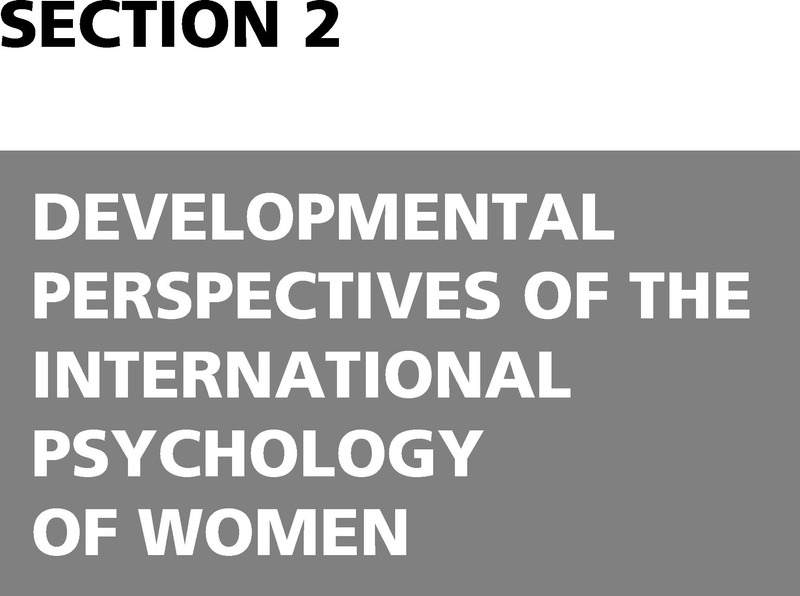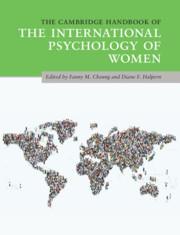Book contents
- The Cambridge Handbook of the International Psychology of Women
- The Cambridge Handbook of the International Psychology of Women
- Copyright page
- Dedication
- Contents
- Figures
- Tables
- Contributors
- Acknowledgments
- Section 1 The Underpinnings of Sex and Gender and How to Study Them
- Section 2 Developmental Perspectives of the International Psychology of Women
- Section 3 Cognitive and Social Factors
- Section 4 Work and Family Issues
- Section 5 Inequality and Social Justice
- Section 6 Health and Well-Being
- Epilogue Some Final Thoughts and Take-Home Messages
- Index
- References
Section 2 - Developmental Perspectives of the International Psychology of Women
Published online by Cambridge University Press: 20 July 2020
- The Cambridge Handbook of the International Psychology of Women
- The Cambridge Handbook of the International Psychology of Women
- Copyright page
- Dedication
- Contents
- Figures
- Tables
- Contributors
- Acknowledgments
- Section 1 The Underpinnings of Sex and Gender and How to Study Them
- Section 2 Developmental Perspectives of the International Psychology of Women
- Section 3 Cognitive and Social Factors
- Section 4 Work and Family Issues
- Section 5 Inequality and Social Justice
- Section 6 Health and Well-Being
- Epilogue Some Final Thoughts and Take-Home Messages
- Index
- References
Summary

- Type
- Chapter
- Information
- Publisher: Cambridge University PressPrint publication year: 2020
References
Suggested Readings

Ivy Wong is an Assistant Professor in the Gender Studies Program at the Chinese University of Hong Kong. She is a gender development psychologist focusing on the expression of gender and its development at the intersection of socialization, cognition, and biology. She studies gender and sexuality across the life span. Her expertise includes gender-typed play, gender differences and similarities, sex segregation, gender socialization, gender variance, gender stereotypes, and sexual orientation. She is interested in bridging the gap between the West and other cultures in research on the psychology of gender. Wong was born in Mainland China, and moved to Hong Kong when she was 6. She was an undergraduate student at the University of Hong Kong. In her third year she obtained a scholarship to spend a full year at Cambridge University. Then she stayed on for an MPhil and PhD at Cambridge where she spent over five years. Wong is a full-blood Teochew, an ethnic Han group from southeastern China. She is fond of the Teochew dialect and traditions that her family is still able to keep.

Doug P. VanderLaan is an Assistant Professor in the Department of Psychology at the University of Toronto Mississauga, and a Collaborator Scientist in Child and Youth Psychiatry at the Centre for Addiction and Mental Health in Toronto. He has conducted community-based and clinical research on the development of gender expression as well as cross-cultural field studies on third gender individuals and sexual orientation in Samoa and Thailand. His other cross-cultural work on these topics has included collaborations with researchers in the Netherlands, Brazil, Japan, mainland China, and Hong Kong. VanderLaan was born in Canada in the Central/Toronto area. He attended college and graduate school in western Canada. VanderLaan has spent long periods of time in Japan, Samoa, and Thailand. He is of Sicilian and Dutch heritage.
References
Suggested Readings

Yang Qu is an Assistant Professor of Human Development and Social Policy in the School of Education and Social Policy at Northwestern University. He received a PhD in Developmental Psychology from the University of Illinois at Urbana-Champaign and completed postdoctoral training at Stanford University. Qu takes an interdisciplinary approach that combines developmental psychology, cultural psychology, and neuroscience to examine how sociocultural contexts shape adolescent development. He studies adolescents from diverse cultural and socioeconomic backgrounds using a variety of methodological approaches, including longitudinal and experimental designs along with survey, observational, and biological (e.g., neuroimaging with fMRI) assessments. Qu was born in Beijing, went to college in Shanghai, and moved to the USA for graduate school.

Shiyu Zhang is a PhD student at the Michigan Program in Survey Methodology at the University of Michigan, Ann Arbor. She recently graduated with an MA in social science (sociology focus) at the University of Chicago. She also has an MA in Migration, Ethnic Relations, and Multiculturalism from Utrecht University, an MSc in Data Science from Tilburg University, and a bachelor’s degree in Psychology from the Chinese University of Hong Kong. Her methodological research interest is in combining survey data and novel forms of data in answering social science questions; her substantive research interest is in family relations between parents and adolescents. She has published in the Journal of Abnormal Child Psychology and the Journal of Research in Personality.

Sylvia Chanda Kalindi is an Instructor in the Faculty of Education at the Mount Saint Vincent University, in Halifax, Nova Scotia. Kalindi was born and raised in Zambia, where she attended college She obtained her master’s degree from the University of Jyväskylä in Finland, and her PhD degree in Developmental Psychology from the Chinese University of Hong Kong. She has worked in Zambia, Hong Kong, and Canada. Her research interests include language and literacy development, and parental support and literacy development, as well as the use of computer intervention strategies to enhance reading development across languages. Sylvia has published in journals such as Reading Research Quarterly and Frontiers in Psychology and contributed to volumes such as The International Encyclopedia of the Social and Behavioural Sciences and The International Handbook of Early Childhood.

Beiming Yang is a PhD candidate in the Human Development and Social Policy program in the School of Education and Social Policy at Northwestern University. He received BA and MSc degrees in Economics from the University of Illinois at Urbana-Champaign. His research interests include cultural differences in adolescents’ motivation, emotion, and decision making, as well as the role of parents in these processes. Yang was born in China and moved to the USA for the last year of high school when he was 16 years old.

Qian Wang is an Associate Professor at the Department of Psychology, the Chinese University of Hong Kong. Wang was born in Chongqing, China and went to Peking University for her undergraduate studies. She then received her PhD degree in Developmental Psychology from the University of Illinois at Urbana-Champaign. Her major research interests include parenting, social and personality development, and cultural influences on socialization and human development. She has published in journals such as Child Development and the Journal of Youth and Adolescence, and contributed to volumes such as The Oxford Handbook of Chinese Psychology and The Handbook of Parenting. Wang identifies herself as ethnically and nationally Chinese, while intellectually “a global citizen.”
References
Suggested Readings
This chapter is based on research supported by the South African Research Chairs initiative of the Department of Science and Technology and National Research Foundation of South Africa, grant number 87582.

Catriona Ida Macleod is Distinguished Professor of Psychology and SARChI Chair of the Critical Studies in Sexualities and Reproduction research programme at Rhodes University, South Africa. Her major scholastic contributions have been in two main areas: sexual and reproductive health, and feminist theory in psychology. She has written extensively in national and international journals in relation to teenage pregnancy, abortion, sexuality education, pregnancy support, feminist psychology, and postcolonialist and poststructural theory. She is author of the multi-award winning book “Adolescence”, pregnancy and abortion: Constructing a threat of degeneration (2011), co-author (with Tracy Morison) of the book Men’s pathways to parenthood: Silence and heterosexual gendered norms (2015) and lead editor of the Palgrave handbook of ethics in critical research (2018). She is editor-in-chief of the international journal Feminism & Psychology. She is vice-chairperson of the Sexual and Reproductive Justice Coalition Board. Macleod was born and raised in South Africa. She attended what was then University of Natal and the University of Cape Town. She has worked extensively throughout South Africa.

Tracy Morison is a Social and Health Psychology lecturer in the School of Psychology at Massey University (New Zealand) and an Honorary Research Associate in the Critical Studies in Sexualities and Reproduction research programme at Rhodes University (South Africa). Morison’s research focus falls within the broad area of sexual and reproductive health, with a particular interest in reproductive “choice,” stigma, and marginalized identities. She works with critical feminist theories and qualitative methodologies. She is the co-author (with Catriona Mcleod) of Men’s pathways to parenthood: Silence and heterosexual gendered norms (2015) and lead editor of Queer kinship: South African perspectives on the sexual politics of family-making and belonging (2019). She is a co-editor of the International Society for Critical Health Psychology weblog. Morison was born and grew up in South Africa. She studied at Rhodes University in Grahamstown. She moved to New Zealand in 2016 to take up a post at Massey University, where she now teaches courses in social psychology and health psychology. She is a feminist health psychologist.
References
Suggested Readings

Amber Xuqian Chen is a research assistant at Motivation and Emotion Laboratory, the Department of Psychology in the Chinese University of Hong Kong. She obtained her bachelor’s degree in Sociology from Sun Yat-sen University in Guangzhou, and her master’s degree in Psychology from the Chinese University of Hong Kong. Her research interests focus on how technology influences social interdependence and emotional interaction across the life span. Chen grew up in mainland China and is now living in Hong Kong. She was an exchange student at University of California, Berkeley. She is deeply intrigued by how individuals change and adapt across contexts and time.

Vivian Hiu Ling Tsang is currently a PhD student at the Department of Psychology, the Chinese University of Hong Kong. She received her BSSc from the Hong Kong Baptist University and an MPhil from the Chinese University of Hong Kong. Her research has focused on interpersonal relationship, social rejection, loneliness, and well-being across adulthood. Tsang was born and grew up in Hong Kong. She worked as an intern at Heartland Human Care Services (International Children’s Center–Youth Residential Services) in Chicago for two months in 2013 during her bachelor’s degree. Later she worked as a research assistant for two years at the Education University of Hong Kong before starting her doctoral studies.

Tze Kiu Wong received her BSSc from the Chinese University of Hong Kong and is currently an MPhil student in Psychology there. Her research focuses on older adults’ engagement. She was born and raised in Hong Kong. Wong considers herself a feminist, although now it is more precise to say that she supports equality of all genders.

Helene H. Fung is the Chairperson and a Professor at the Department of Psychology, and the Executive Director of the Centre for Positive Social Science, at the Chinese University of Hong Kong. Fung examines social motivation and cognition across adulthood. She won the 1998 Margaret Clark Paper Award from the Association of Anthropology and Gerontology, and the 1999 Behavioral and Social Science Pre-dissertation Research Award and the 2010 Margret and Paul Baltes award in Behavioral and Social Gerontology from the Gerontological Society of America. She is an associate editor for the Australian Journal of Psychology. Fung grew up in Hong Kong. She emigrated to Canada in the early 1990s and is now a Canadian citizen residing in Hong Kong. She attended college (University of Washington, Seattle) and graduate school (Stanford University) in the USA. She has been visiting Germany every summer since 2003 and was a Visiting Professor at Ewha Woman’s University in South Korea for two months in 2018. She worked as a volunteer at a nursing home for Chinese older adults in Seattle during her college years. She can understand many Chinese dialects. This has greatly enriched her career as a researcher on aging, allowing her to communicate with Chinese older adults with diverse background.

Liat Ayalon is a Professor at Bar Ilan University, School of Social Work. Her main area of focus for the past few years has been ageism - the (often) negative construction of old age. She is the chair (with Prof. Tesch-Römer) of a COST Action on Ageism from a multinational, interdisciplinary perspective (COST IS1402). She is also the coordinator of a new Marie Curie Innovative Training Network on Ageism (EuroAgeism). Ayalon was born and raised in Israel. She lived in the United States for seven years. She attended graduate school at Illinois Institute of Technology in Chicago, and internship and postdoctoral training at the University of California, San Francisco. Although her doctoral degree is in Clinical Psychology, her internship was in a department of geriatrics. She specializes in the psychosocial aspects of aging.



